One study found that anywhere between 2 to 14 percent of people who get Covid-19 will also develop POTS.
When Jill Brook was 17, she began to notice that standing, or even just sitting upright for more than a few minutes at a time, became a struggle. It seemed like her body was in constant battle with gravity.
“It felt like my blood was sinking — like there was never enough in my head and too much in my legs,” she says.
Her parents took her to doctor after doctor; all of them were mystified. Meanwhile, Brook kept getting worse. The pain in her legs intensified, she went through periods where she couldn’t even sit up, and began passing out during the summer heat, or even while taking a hot shower. She was desperate for a diagnosis and even resorted to creating a website (with the short-lived domain name “mylegshurt.com”) in the hopes that if she cast her symptoms out into the internet, someone would stumble upon the site and be able to tell her what was wrong.
It took 17 years before she was diagnosed with a poorly understood condition called postural orthostatic tachycardia syndrome, or POTS. Back then, more than 15 years ago, few people had ever heard of it. But since the pandemic, there’s been a surge in new POTS cases, says Pam Taub, M.D., a professor at the UC San Diego School of Medicine, who studies the disorder and is searching for new ways to treat it.
“Before Covid, the thought was there were between 1 to 3 million people with POTS,” Dr. Taub says. “My really conservative estimate is that there are probably about a million new cases due to Covid.”
What is POTS?
POTS is a disorder of the autonomic nervous system, which regulates the body’s most basic functions, from breathing to heart rate. People with it report dizziness, brain fog, leg pain, and a racing heart, and the condition disproportionately affects young women. (Studies indicate that about 80 percent of POTS patients are women.) Some can live relatively normal lives with treatment, while others are left completely wheelchair-bound. About 25 percent of people with POTS are considered medically disabled.
Researchers aren’t quite sure what causes POTS, but they have a few working theories. One is that it may stem from overall low blood volume, and to compensate, the heart pumps faster to push blood up to the brain, the lungs, and other vital organs when a person’s standing upright. Another hypothesis is that there’s an autoimmune component, which is why it’s thought that the condition can be triggered by a viral infection like Covid-19, Dr. Taub says.
“We’re seeing a lot of relatively healthy people with no issues get Covid, and then go on to develop POTS,” she says. “What that’s telling me is that the virus serves as a stress on the immune system that’s bringing out this underlying predisposition.”
How many people will be affected isn’t clear: One study found that anywhere between 2 to 14 percent of people who get Covid-19 will also develop POTS; another analysis concluded that about 30 percent of long Covid patients may meet the criteria for it. But what is clear is that the pandemic has greatly raised POTS’ profile, says Cathy Pederson, Ph.D., a biology professor at Wittenberg University in Ohio and the founder of a POTS advocacy group.
Raising awareness
A decade ago, when Dr. Pederson’s own daughter became sick, there was so little awareness about POTS that it took nine months and four different hospitals (and many more doctors) to get her diagnosed. “That’s really fast,” she says, compared to most others. Many of those afflicted, like Brook, go years without learning what’s wrong with them.
POTS can’t be detected on an MRI, CAT scan, or through a blood or urine test. The only reliable way to tell if someone has it is to see if their heart rate spikes when they go from lying down to standing. It’s a relatively simple evaluation, but many physicians didn’t know about POTS until recently. (It wasn’t officially recognized until the 90s.) Before that, when patients came to them with this confusing constellation of symptoms, they often couldn’t give them the answers they needed or, worse, didn’t believe them, Dr. Pederson says.
“It’s an invisible illness,” she tells us. Someone suffering from it may look healthy and might have perfect bloodwork, which sets them up for medical gaslighting. Dr. Taub says it’s not uncommon for people to get dismissed as either just “being anxious or stressed.” And the emotional toll of not being trusted compounds the physical pain of the condition, Brook says.
“The world not meeting their needs very well, or being critical or judgemental, or not believing them, makes the suffering worse for a lot of patients,” she tells us.
But as more people (including celebs like Real Housewives alum Bethenny Frankel and the artist Halsey) are becoming sick with the disorder, a larger swath of the medical community, and Americans at large, have come to learn about POTS and its warning signs. And Dr. Taub thinks that patients may be diagnosed a bit faster because of it.
There’s another positive, too — the emergence of national funding for POTS research. The National Institute of Health launched a large-scale effort in 2021 to study and develop new therapies for long Covid and related conditions, including POTS. But currently, there isn’t a cure for the syndrome and not many effective interventions. (Common treatments include drinking tons of fluid and taking salt tablets, which raises blood volume, and wearing compression socks, which helps prevent the blood from pooling in the legs.) But experts are hopeful that new research will change that.
“It’s really the first time that we’re seeing national funding for POTS, which is absolutely fantastic,” Dr. Pederson says. “That really is a silver lining.”









